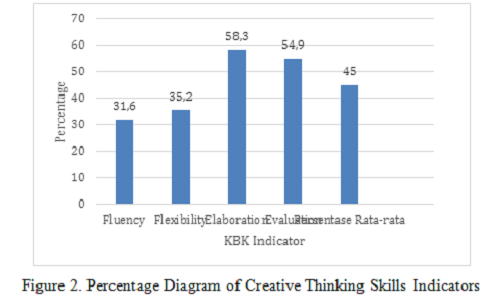
Building Students' Creative Thinking Skills Using Problem- Based Learning in Handling Staple Food Waste
Abstract
This study aims to build students' creative thinking skills using problem - based learning in handling staple food waste. The research methods are development and research with the stages of design, development, and evaluation. This research was conducted at a private high school in Tangerang Regency. The research was involved thirty students of Class XI IPA in the second semester of the 2019/2020 school year and was connected through the WhatsApp group. The research instrument used Student Worksheets (LKS) in the form of a test essay for nine items that have been validated to measure students’ creative thinking skills. The research data were analyzed quantitatively by using Microsoft Excel and qualitative- descriptive. The results of the students' creative thinking skills showed the percentage of fluency (31.66%), flexibility (35.18%), elaboration (58.33%), and evaluation (54.88%) indicators, the average percentage was 45.01% categorized as medium. The conclusions drawn are the creative thinking skills that emerge after using problem-based learning are fluent thinking, flexibility thinking, evaluative thinking, and elaborative thinking.
Keywords
Full Text:
PDFReferences
Abdurrozak, R., Jayadinata, A. K., & Isrok’atun. (2016). Pengaruh model problem-based learning terhadap kemampuan berpikir kreatif siswa. Jurnal Pena Ilmiah, 1(1), 871-880.
Agustin, S., Fadiawati, N., & Diawati, C. (2018). Efektivitas pembelajaran berbasis masalah pencemaran limbah pemutih dalam meningkatkan keterampilan berpikir kreatif. Jurnal Pendidikan dan Pembelajaran Kimia, 7(2), 1-12.
Arikunto, S. (2006). Dasar-dasar evaluasi pendidikan. Jakarta: Bumi Aksara.
Azizah, F. N., Rosbiono, M., & Sopandi, W. (2019). Kontribusi tindakan kreatif pada penguasaan konsep siswa melalui problem-based learning pada konteks pengawetan apel. Jurnal Pendidikan Kimia Undiksha, 3(1), 9-19.
Birgili, B. (2015). Creative and critical thinking skills in problem-based learning environments. Journal of Gifted Education and Creativity, 2(2), 71-80.
Charif, M. (2010). The effects of problem-based learning in chemistry education on middle school students’ academic achievement and attitude. Amerika: Lebanese American University.
Ersoy, E., & Baser, N. (2014). The effects of problem-based learning method in higher education on creative thinking. Procedia-Social and Behavioral Sciences, 116, 3494-3498.
Fahruroji, T., Kurnia., & Rosbiono, M. (2016). Penerapan pembelajaran berbasis masalah untuk meningkatkan kemampuan kognitif dan kreativitas siswa pada topik biogas. Jurnal Ilmu Pendidikan dan Pengajaran, 3(3), 234-242.
Friani, I. F., Sulaiman., & Mislinawati. (2017). Kendala guru dalam menerapkan model pembelajaran pada pembelajaran tematik berdasarkan kurikulum 2013 di SD Negeri 2 Kota Banda Aceh. Jurnal Ilmiah Pendidikan Guru Sekolah Dasar, 2(1), 88-97.
Herdiawan, H., Langitasari, I., & Solfarina. (2019). Penerapan PBL untuk meningkatkan keterampilan berpikir kreatif siswa pada konsep koloid. Jurnal Kimia dan Pendidikan, 4(1), 24-35.
Iqbal, M., Yusrizal., & Abidin, Z. (2018). The development of learning instruments through the problem-based learning model to enhance students’ creativity. Journal of Physics, 1088, 1-6.
Kartamiharja, M. R., Sopandi, W., & Anggraeni, D. (2020). Implementation of problem-based learning (PBL) approach in chemistry instructional with context of tofu liquid waste treatment. International Journal of Learning, Teaching and Educational Research, 19(5), 47-77.
Kristiani, S. U. Y., & Muchlis. (2017). Penerapan model pembelajaran inkuiri terbimbing pada materi kesetimbangan kimia untuk melatihkan keterampilan berpikir kreatif siswa kelas XI SMA Negeri 12 Surabaya. Journal of Chemical Education, 6(2), 202-207.
Lase, D. (2019). Pendidikan di era revolusi industri 4.0. Jurnal Sundermann, 1(1), 28-43.
Munandar, U. (2014). Pengembangan kreativitas anak berbakat. Jakarta: Rineka Cipta.
Nurdyansyah., & Fahyuni, E. F. (2016). Inovasi model pembelajaran sesuai kurikulum 2013. Sidoarjo: Nizamial Learning Center.
Nuswowati, M., & Taufiq, M. (2015). Developing creative thinking skills and creative attitude through problem-based green vision chemistry environment learning. Jurnal Pendidikan IPA Indonesia, 4(2), 170-176.
Oktaviani, C., Nurmaliah, C., & Mahidin. (2017). Implementasi model problem-based learning terhadap kreativitas peserta didik pada materi laju reaksi di SMAN 4 Banda Aceh. Jurnal Pendidikan Sains Indonesia, 5(1), 12-19.
Ratnasari, D., Supriyanti, T., & Rosbiono, M. (2017). Vocational high school students’ creativity in food additives with problem-based learning approach. International Conference on Mathematics and Science Education, 895.
Richey, R. C., Klein, J. D., & Nelson, W. A. (2015). Developmental research studies of instructional design and development. ResearchGate.
Turkmen, H., & Sertkahya, M. (2015). Creative thinking skills analyzes of vocational high school students. Journal of Educational and Instructional Studies in the World, 5(1), 74-84.
Ulger, K. (2018). The effect of problem-based learning on the creative thinking and critical thinking disposition of students in visual arts education. Interdisciplinary Journal of Problem-Based Learning, 12(1), 1-21.
Wulandari, W., Liliasari., & Supriyanti, T. (2011). Problem-based learning untuk meningkatkan keterampilan berpikir kreatif dan penguasaan konsep siswa pada materi larutan penyangga. Jurnal Pengajaran MIPA, 16(2), 116-121.
Yoon, H., Woo, A. J., Treagust, D. F., & Chandrasegaran, A. L. (2015). Second-year college students’ scientific attitudes and creative thinking ability influence of a problem-based learning (PBL) chemistry laboratory course. Affective Dimensions in Chemistry Education, 217-233.
Yuliani, H., Mariati., Yulianti, R., & Herianto, C. (2017). Keterampilan berpikir kreatif pada siswa sekolah menengah di palangkaraya menggunakan pendekatan saintifik. Jurnal Pendidikan Fisika dan Keilmuan (JPFK), 3(1), 48-56.
DOI: http://dx.doi.org/10.31258/jes.5.1.p.89-103
Refbacks
- There are currently no refbacks.
Copyright (c) 2021 Rista Firdausa Handoyo, Momo Rosbiono, Wahyu Sopandi

This work is licensed under a Creative Commons Attribution 4.0 International License.
Publisher: FKIP Universitas Riau












